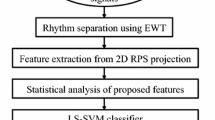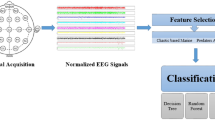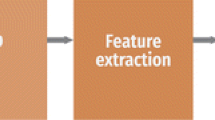Abstract
Cardiovascular diseases are identified as one of the most dangerous diseases and the major causes of the death around the world. One of the most common cardiac arrhythmias that have always been a concern for cardiologists is premature ventricular contractions. Regarding its abundance among all ages, prediction and diagnosis of this type of arrhythmia has particular importance. One of the most common, most non-invasive; and the least costly method for investigation of heart diseases is to record and analyze the electrocardiogram (ECG) signals. The purpose of this study is to analyze the ECG in order to classify premature ventricular contraction heartbeats. Having proposed a new technique based on evolutionary optimization for R peak detection, several methodologies, such as morphological assessment, polynomial curve fitting, discrete wavelet transform, and nonlinear analysis, are employed to extract features from ECG signal. Support vector machine (SVM) classifier with a linear kernel is used to detect the normal and PVC heart rates. In order to evaluate the proposed method, in addition to the MIT-BIH database, the experimental data is used and the methodology performance is proved for both databases. Finally, using different feature selection criteria such as fisher distinction, minimal-redundancy maximum-relevance, and SVM-based recursive feature elimination with correlation bias reduction, six features are introduced as best ones. The proposed PVC detection algorithm acquires the overall detection accuracy of 99.78%, with the sensitivity of 99.91% and specificity of 99.37%, for MIT-BIH dataset.













Similar content being viewed by others
References
Asl, B.M., Setarehdan, S.K., Mohebbi, M.: Support vector machine-based arrhythmia classification using reduced features of heart rate variability signal. Artif. Intell. Med. 44(1), 51–64 (2008)
Ge, D., Srinivasan, N., Krishnan, S.M.: Cardiac arrhythmia classification using autoregressive modeling. Biomed. Eng. Online 1(1), 5 (2002)
Acharya, U.R., Joseph, K.P., Kannathal, N., Lim, C.M., Suri, J.S.: Heart rate variability: a review. Med. Biol. Eng. Comput. 44(12), 1031–1051 (2006)
Berkaya, S.K., Uysal, A.K., Gunal, E.S., Ergin, S., Gunal, S., Gulmezoglu, M.B.: A survey on ECG analysis. Biomed. Signal Process. Control 43, 216–235 (2018)
Chen, Z., Xu, H., Luo, J., Zhu, T., Meng, J.: Low-power perceptron model based ECG processor for premature ventricular contraction detection. Microprocess. Microsyst. 59, 29–36 (2018)
Ghorbanian, P., Ghaffari, A., Jalali, A., Nataraj, C.: Heart arrhythmia detection using continuous wavelet transform and principal component analysis with neural network classifier. In: In Computing in Cardiology, pp. 669–672. IEEE (2010)
Melgani, F., Bazi, Y.: Detecting premature ventricular contractions in ECG signals with Gaussian processes. In: Computers in cardiology, pp. 237–240. IEEE (2008)
Sayadi, O., Shamsollahi, M.B., Clifford, G.D.: Robust detection of premature ventricular contractions using a wave-based Bayesian framework. IEEE Trans. Biomed. Eng. 57(2), 353–362 (2010)
Kumar, A., Singh, M.: Ischemia detection using isoelectric energy function. Comput. Biol. Med. 68, 76–83 (2016)
Zhou, F.Y., Jin, L.P., Dong, J.: Premature ventricular contraction detection combining deep neural networks and rules inference. Artif. Intell. Med. 79, 42–51 (2017)
de Chazal, P., Reilly, R.B: Automatic classification of ECG beats using waveform shape and heart beat interval features. In: 2003 IEEE international conference on acoustics, speech, and signal processing. Proceedings. (ICASSP’03), Vol. 2, pp. II–269. IEEE (2003)
Prakash, S., Sangeetha, K., Ramkumar, N.: An optimal criterion feature selection method for prediction and effective analysis of heart disease. Clust. Comput. (2018). https://doi.org/10.1007/s10586-017-1530-z
Gokulnath, C.B., Shantharajah, S.P.: An optimized feature selection based on genetic approach and support vector machine for heart disease. Clust. Comput. (2018). https://doi.org/10.1007/s10586-018-2416-4
Allami, R.: Premature ventricular contraction analysis for real-time patient monitoring. Biomed. Signal Process. Control 47, 358–365 (2019)
Sayadi, O., Shamsollahi, M.B.: ECG denoising and compression using a modified extended Kalman filter structure. IEEE Trans. Biomed. Eng. 55(9), 2240–2248 (2008)
Zarei, R., He, J., Huang, G., Zhang, Y.: Effective and efficient detection of premature ventricular contractions based on variation of principal directions. Digit. Signal Process. 50, 93–102 (2016)
Jung, Y., Kim, H.: Detection of PVC by using a wavelet-based statistical ECG monitoring procedure. Biomed. Signal Process. Control 36, 176–182 (2017)
Bhoi, A.K., Sherpa, K.S., Khandelwal, B.: Arrhythmia and ischemia classification and clustering using QRS-ST-T (QT) analysis of electrocardiogram. Clust. Comput. 21(1), 1033–1044 (2018)
Inan, O.T., Giovangrandi, L., Kovacs, G.T.: Robust neural-network-based classification of premature ventricular contractions using wavelet transform and timing interval features. IEEE Trans. Biomed. Eng. 53(12), 2507–2515 (2006)
Ince, T., Kiranyaz, S., Gabbouj, M.: Automated patient-specific classification of premature ventricular contractions. In: 30th Annual international conference of the IEEE Engineering in Medicine and Biology Society, pp. 5474–5477. EMBS (2008)
Ebrahimzadeh, A., Khazaee, A.: Detection of premature ventricular contractions using MLP neural networks: a comparative study. Measurement 43(1), 103–112 (2010)
Sotomi, Y., Iwakura, K., Higuchi, Y., Abe, K., Yoshida, J., Masai, T., Fujii, K.: The impact of systemic vascular resistance on the accuracy of the FloTrac/Vigileo™ system in the perioperative period of cardiac surgery: a prospective observational comparison study. J. Clin. Monit. Comput. 27(6), 639–646 (2013)
Martis, R.J., Acharya, U.R., Min, L.C.: ECG beat classification using PCA, LDA, ICA and discrete wavelet transform. Biomed. Signal Process. Control 8(5), 437–448 (2013)
Attin, M., Feld, G., Lemus, H., Najarian, K., Shandilya, S., Wang, L., Sabouriazad, P., Lin, C.D.: Electrocardiogram characteristics prior to in-hospital cardiac arrest. J. Clin. Monit. Comput. 29(3), 385–392 (2015)
Hayashi, H., Miyamoto, A., Ishida, K., Yoshino, T., Sugimoto, Y., Ito, M., Horie, M.: Prevalence and QT interval of early repolarization in a hospital-based population. J. Arrhythm. 26(2), 127–133 (2010)
Mukherjee, A., Ghosh, K.K.: An efficient wavelet analysis for ECG signal processing. In: 2012 International Conference on Informatics, Electronics & Vision (ICIEV), pp. 411–415. IEEE (2012)
Malakhov, A.I., Schookin, S.I., Ivancov, V.I., Tikhomirov, A.N.: A combined algorithm for identification and differentiation of atrial flutter and atrial fibrillation based on ECG analysis. Biomed. Eng. 47(1), 14–17 (2013)
Boquete, L., Ascariz, J.M.R., Cantos, J., Barea, R., Miguel, J.M., Ortega, S., Peixoto, N.: A portable wireless biometric multi-channel system. Measurement 45(6), 1587–1598 (2012)
Jindapetch, N., Chewae, S., Phukpattaranont, P.: FPGA implementations of an ADALINE adaptive filter for power-line noise cancellation in surface electromyography signals. Measurement 45(3), 405–414 (2012)
Rebergen, D.J., Nagaraj, S.B., Rosenthal, E.S., Bianchi, M.T., van Putten, M.J., Westover, M.B.: ADARRI: a novel method to detect spurious R-peaks in the electrocardiogram for heart rate variability analysis in the intensive care unit. J. Clin. Monit. Comput. 32(1), 53–61 (2018)
Mahmoud, S.A., Bamakhramah, A., Al-Tunaiji, S.A.: Low-noise low-pass filter for ECG portable detection systems with digitally programmable range. Circuits Syst. Signal Process. 32(5), 2029–2045 (2013)
Zou, Y., Han, J., Xuan, S., Huang, S., Weng, X., Fang, D., Zeng, X.: An energy-efficient design for ECG recording and R-peak detection based on wavelet transform. IEEE Trans. Circuits Syst. II 62(2), 119–123 (2015)
Alonso-Atienza, F., Morgado, E., Fernandez-Martinez, L., García-Alberola, A., Rojo-Alvarez, J.L.: Detection of life-threatening arrhythmias using feature selection and support vector machines. IEEE Trans. Biomed. Eng. 61(3), 832–840 (2014)
Liu, L., Chen, L., Zhang, Y.H., Wei, L., Cheng, S., Kong, X., Zheng, M., Huang, T., Cai, Y.D.: Analysis and prediction of drug–drug interaction by minimum redundancy maximum relevance and incremental feature selection. J. Biomol. Struct. Dyn. 35(2), 312–329 (2017)
Duan, K.B., Rajapakse, J.C., Wang, H., Azuaje, F.: Multiple SVM-RFE for gene selection in cancer classification with expression data. IEEE Trans. Nanobiosci. 4(3), 228–234 (2005)
Koley, B., Dey, D.: An ensemble system for automatic sleep stage classification using single channel EEG signal. Comput. Biol. Med. 42(12), 1186–1195 (2012)
Hidalgo-Muñoz, A.R., López, M.M., Santos, I.M., Pereira, A.T., Vázquez-Marrufo, M., Galvao-Carmona, A., Tomé, A.M.: Application of SVM-RFE on EEG signals for detecting the most relevant scalp regions linked to affective valence processing. Expert Syst. Appl. 40(6), 2102–2108 (2013)
Ding, X., Yang, Y., Stein, E.A., Ross, T.J.: Multivariate classification of smokers and nonsmokers using SVM-RFE on structural MRI images. Hum. Brain Mapp. 36(12), 4869–4879 (2015)
Kim, E.Y., Lee, M.Y., Kim, S.H., Ha, K., Kim, K.P., Ahn, Y.M.: Diagnosis of major depressive disorder by combining multimodal information from heart rate dynamics and serum proteomics using machine-learning algorithm. Prog. Neuropsychopharmacol. Biol. Psychiatry 76, 65–71 (2017)
Tang, Y., Zhang, Y.Q., Huang, Z.: Development of two-stage SVM-RFE gene selection strategy for microarray expression data analysis. IEEE/ACM Trans. Comput. Biol. Bioinf. 4(3), 365–381 (2007)
Yan, K., Zhang, D.: Feature selection and analysis on correlated gas sensor data with recursive feature elimination. Sens. Actuators B 212, 353–363 (2015)
Futou, L., Liang, L.: Decision making based on grey model and support vector machine. Clust. Comput. (2018). https://doi.org/10.1007/s10586-018-2227-7
Jafarian, K., Mobin, M., Jafari-Marandi, R., Rabiei, E.: Misfire and valve clearance faults detection in the combustion engines based on a multi-sensor vibration signal monitoring. Measurement 128, 527–536 (2018)
Moody, G.B., Mark, R.G.: The impact of the MIT-BIH arrhythmia database. IEEE Eng. Med. Biol. Mag. 20(3), 45–50 (2001)
Acknowledgements
Authors are grateful to Dr. Ahmad Masoudi, Head of the Cardiac Intensive Care Unit, Qeshm Hospital, Qeshm Island, Iran, for his clinical help and outstanding suggestions to improve the quality of this manuscript.
Author information
Authors and Affiliations
Corresponding author
Additional information
Publisher's Note
Springer Nature remains neutral with regard to jurisdictional claims in published maps and institutional affiliations.
Rights and permissions
About this article
Cite this article
Mazidi, M.H., Eshghi, M. & Raoufy, M.R. Detection of premature ventricular contraction (PVC) using linear and nonlinear techniques: an experimental study. Cluster Comput 23, 759–774 (2020). https://doi.org/10.1007/s10586-019-02953-x
Received:
Revised:
Accepted:
Published:
Issue Date:
DOI: https://doi.org/10.1007/s10586-019-02953-x




